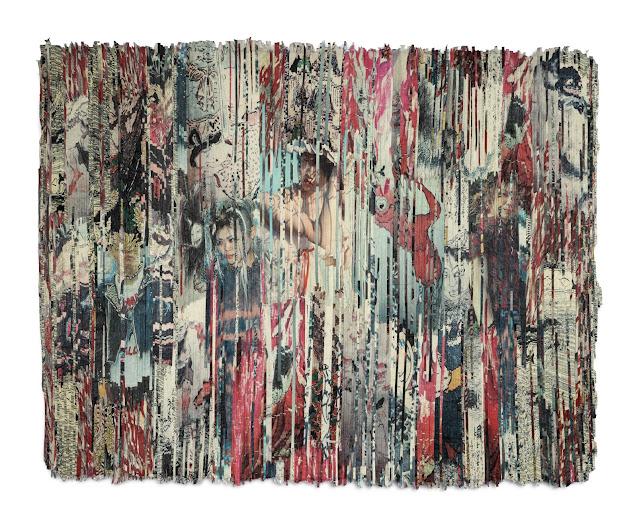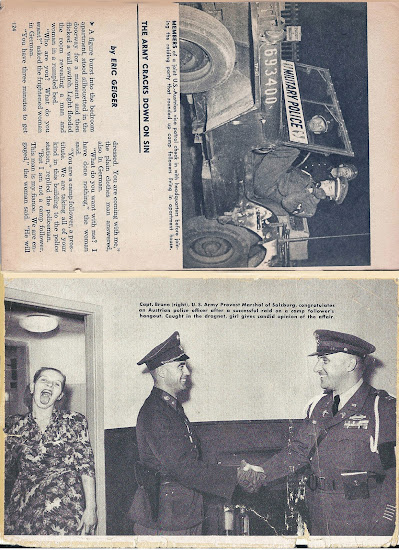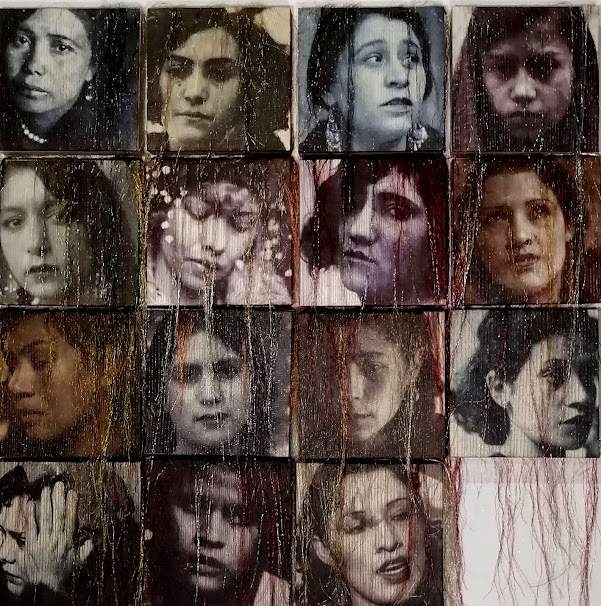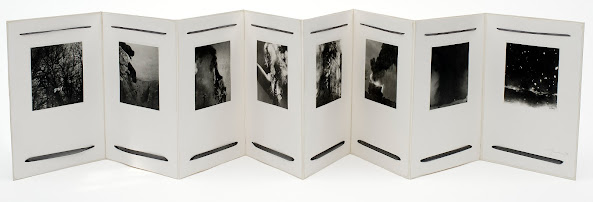On December 15th in the Victoria and Albert Museum, London, the ninth edition of the Prix Pictet was inaugurated. A panel discussion examining the theme, "Fire" as well aspects of the work of various of the shortlisted photographers and artists, had been planned for that same afternoon, but was canceled for concerns about Covid. As I already had prepared my presentation, I've decided to present it here.
El 15 de diciembre en el museo Victoria and Albert, Londres, se inauguró la edición nueve del Prix Pictet. Estaba calendarizado una discusión del tema del premio, "Fuego", y aspectos de la obra de varios de sus finalistas para la tarde de la inauguración, pero la mesa redonda se tuvo que cancelar por el tema del Covid. Como ya tenía preparada mi intervención, la asiento aquí.
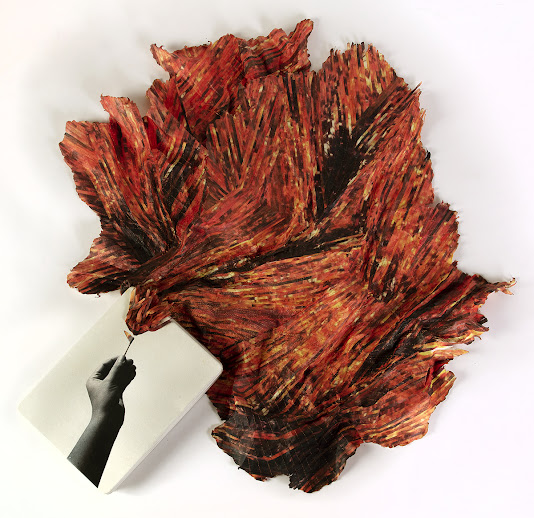
Fire- Fuego (o, La caja de Pandora- Pandora's Box) 2009 (versión 2021)
Carla Rippey: I am actually a visual artist, not a photographer, although my father was a photographer and photojournalist and so I grew up with photographic concepts –ideas about composition, cropping, juxtaposition and the creation of visual narratives. In fact, I figured out a few years ago that probably my biggest influences were patchwork quilts, and Edward Steichen’s book “The Family of Man”. From early on as an artist, I’ve worked with archives, and what is now called appropriation, collecting the images that catch my eye or create an echo for me. Here we see my part of my archives for the work in this show.
La verdad, soy artista visual, no fotógrafa, pero mi padre sí fue fotógrafo y fotoperiodista y así crecí familiarizada con conceptos fotográficos-- ideas sobre composición, encuadres y yuxtaposición y la creación de narrativas visuales, por ejemplo. Es más, hace unos años me di cuenta que mis influencias más grandes como artista han sido, probablemente, las colchas de parches (patchwork) del medio oeste y el libro/catálogo de Edward Steichen, "The Family of Man". Desde hace mucho, como artista he trabajado con archivos, y con lo que ahora se llama "apropiación", coleccionando las imágenes que me llaman la atención o que crean un eco para mí.
fire archives / archivos de fuego
Around 1990 I started making artist’s books and installations with photocopies transferred with paint thinner onto Japanese and other papers and cloth. This work is a sort of mid-life piece made from my archives of vanishing points, called “From the Finite to the Infinite”. My work is always extremely personal, I start off trying to articulate something for myself, with the hope that the work will resonate on another level, for others.
Cerca de 1990 empecé a hacer libros de artista e instalaciones con fotocopias transferidas con solvente a papeles japoneses y otros, y tela. Esta pieza es una especie de pieza de la mitad de la vida hecho con mis archivos de puntos de fuga, llamada "Del finito al infinito". Mi obra suele ser bastante personal; empiezo tratando de articular algo para mi misma, con la esperanza que la obra pueda resonar para los demás, en algún nivel, en algún momento.
From the Finite to the Infinite / Del finito al infinito, 1998
For a long time now my principal medium has been drawing- graphite on paper, which I also base on photos, as with this version of a scene from a post WWII magazine:
Desde hace mucho dibujo (grafito/papel) ha sido el medio de expresión al cual más concurro, como en mi versión de una escena de una revista de los años después de la Segunda Guerra Mundial:
Operación Camp Follower, 2021
Based on this photograph documenting a "successful" operation against Austrian girls hanging out with Allied soldiers-
Basado en esta fotografía de un artículo sobre la operación "exitosa" para controlar a jóvenes austriacas paseando con soldados aliados-
Pages from the magazine -- /Páginas de la revista -- 195-
I’ve also worked a lot with the Mexican national photo archives, especially with images of women detained in Mexico City police stations in the thirties--
He trabajado mucho con los archivos del INAH, en la Fototeca Nacional de México, particularmente con imágenes de mujeres detenidas en delegaciones de la Ciudad de México en los años 1930s-

For instance, I've interpreted photographs taken by the Casasola brothers in different ways, in drawings-
Por ejemplo, he interpretado fotografías de los Hermanos Casasola en distintas maneras, en dibujo-
Woman surrounded by three agents, c. 1933 / Mujer rodeada por tres agentes, 2001
And transfer prints sewn upon and made into installations-
E impresiones en transferencia con costura, armadas en instalaciones-
Women before the Court / Mujeres frente al tribunal 2021
Detalle, Women before the Court / Mujeres frente al tribunal 2021
I’ve also used a lot of found material from flea markets, like this carnival scene--
También he ocupado mucho material de mercados de pulga, como esta escena de carnaval-
Found photograph, Veracruz carnival / Fotografía encontrada, carnaval en Veracruz
Which I cropped and used for a large drawing. Here I should add that the fact that I live in Latin America has affected me and my work a lot, not only with the kind of source material I find, but for the experience of living a more complex reality than I would have found staying in the United States. Here, we must process the imposed view of reality that comes from the cultural domination of the Center, especially the US, and conciliate it with the very different reality of our daily lives.
Escena que encuadré y ocupé para un dibujo grande. Aquí quisiera agregar que el hecho de vivir en América Latina me ha afectado bastante, en mi vida y mi obra, no solamente por el tipo de material fuente que pueda encontrar, pero también por la experiencia de vivir una realidad más compleja que la que habría encontrada si me hubiera quedado en Estados Unidos. Aquí tenemos que procesar la visión impuesta, por la dominación cultural del Centro, particularmente de Estados Unidos, y conciliarla con la muy distinta realidad que percibimos en nuestras vidas diarias.
Carnival / Carnaval 2001
But I also go back to my roots for some projects. In recent years I've done a lot of work with photographs my father took during my childhood, making drawings-
También vuelvo a mis raíces para mis proyectos. En años recientes he trabajado mucho con fotografías que mi padre tomé en mi infancia, transformándolas en dibujos-
Farnam Street, c. 1956, 2020
And in artist’s books. I was trying to recapture something of the mystery of infancy and the minds of children- their imaginaries-
Y en libros de artistas. Estaba intentando recapturar algo del misterio de la infancia y las mentes de los infantes- sus imaginarios-
We girls at nightfall / Nosotras al anochecer 2020
But as I delved into childhood dreams and dreads, I ended up including found images from the internet as well, and things got darker or more complicated-
Pero al adentrarme en los sueños y pavores de la infancia, terminé incluyendo también imágenes del internet, y todo se volvió más oscuro y complicado-
Bad rabbit series /Serie Conejos malditos 2019
I started working with government and university archives in the early 2000s, with this installation called “The Extremes of America”, in which I juxtaposed images of the original peoples of the very north and very south of the continents.
Empecé a trabajar con archivos gubernamentales y universitarios en los 2000s tempranos, con esta instalación llamada "Los extremos de América", en el cual yuxtaponía imágenes de los pueblos originarios del extremo sur y norte de las Américas.
The extremes of America / América en extremo, 2006-8
Later on I made a more extensive piece linking up the history of the migration of my own forbearers in the Great Plains with the history of Mexican presence and migrations, going down to Texas, the border during the Mexican Revolution, and Mexico itself, working with official archives in the US and Mexico. Here I realized the importance of photographers in the recording of history, because only where they happened to end up, did I find a specific visual record.
Más adelante, hice una pieza más extensiva ligando la historia de migración de mis propios antepasados en la pradera central de Estados Unidos con la de la presencia mexicano y sus periplos, pasando a Texas, la frontera durante la Revolución Mexicana, y a México mismo, trabajando con archivos oficiales en Estados Unidos y México. Aquí es donde me dio cuenta de la gran importancia de fotógrafos en la documentación de la historia, porque solamente donde por casualidad llegó un fotógrafo, existe una registro visual notable.
When my blood was not yet my blood, in exhibition / Cuando mi sangre aún no era mi sangre, en exposición, Museo Carrillo Gil 2016
I’ve also made work from movie stills, as in this scene of the protagonist being abandoned and forcing a kiss from his lover taken from the Kurosawa movie “Drunken Angel”.
También he hecho obra de fotos fijas de películas, como en esta escena del protagonista siendo abandonado y robando un beso final de su amante, tomada de la película de Kurosawa "Ángel borracho".
A Pillow Book, 2001
Another artist’s book uses source material from many different cultures, it’s called “The Creature Walks Among Us” (the name of a movie I saw as a little girl) and explores the beautiful and the terrible in different societies.
Otro libro de artista ocupa material de muchas culturas distintas, se llama "The Creature walks Among Us" y explora lo bello y lo terrible en distintas culturas.
I also use images found on line to express personal experience metaphorically, as in this work called “Grief”, about the death of my sister and the process of grieving.
También, utilizo imágenes que encuentro en línea para expresar, metafóricamente, experiencia personal, como en esta obra, "Duelo", sobre la muerte de mi hermana y el proceso de duelo.
Grief, 2017
And nowadays I’m working on drawings of asteroids, artefacts and relics, also based on photos.
Y ahora estoy trabajando en dibujos de asteroides, artefactos y reliquias, también basadas en fotos.
__________________________________
About the Prix Pictet: / Sobre el Prix Pictet:
"The Prix Pictet aims to harness the power of photography – all genres of photography – to draw global attention to issues of sustainability, especially those concerning the environment.
Founded in 2008 by the Pictet Group, the Prix Pictet has become the world’s leading award for photography and sustainability. To date, there have been eight cycles of the award each of which has highlighted a particular facet of sustainability. The nine themes are Water, Earth, Growth, Power, Consumption, Disorder, Space, Hope and Fire."
El Prix Pictet busca aprovechar el poder de la fotografía -todos los géneros de fotografía - para atraer atención global a asuntos de sustentabilidad, particularmente en referencia al medio ambiente.
Fundada en 2008 por el Grupo Pictet, el Prix Pictet se ha vuelto el principal premio mundial en el campo de fotografía y sustentabilidad. Hasta ahora, han habido ocho ciclos del premio; cada uno ha enfatizado un aspecto particular de sustentabilidad. Los nueve temas son Agua, Tierra, Crecimiento, Poder, Consumo, Desorden, Espacio, Esperanza y Fuego.
"Entry to the award is strictly by nomination. The network of nominators worldwide (currently numbering 300) have, over the course of the eight cycles, nominated 4,700 artists for the award. Taken together the nominated works present a powerful testament to the fragile state of our planet.
Since 2008 the eight cycles of the Prix Pictet have been shown in exhibitions in many major cities of the world with visitor numbers of over 550,000."
Entrada al premio es estrictamente por nominación. La red de nominadores mundialmente (en este momento son más que 300) ha nominado, sobre el transcurso de ocho ciclos, 4,700 artistas para el premio. Tomadas juntas, las obras nominadas presentan un testamento poderoso al estado frágil del planeta.
Desde 2008 los ocho ciclos del Prix Pictet han sido presentados en exposiciones en muchas ciudades significantes de mundo, con el número de visitas arriba de los 550,000.
Virtual tour of the present exhibit in the Victoria and Albert Museum / Tour virtual de la exposición actual en el museo Victoria y Albert: https://my.matterport.com/show/?m=77Yddda3d4d
Portfolios de los finalistas del Prix Pictet 2021 / Portfolios of the 2021 Prix Pictet shortlisted artists- Joana Hadjithomas and Khalil Joreige, Lisa Oppenheim, Mak Remissa, Mark Ruwedel, Rinko Kawauchi, Sally Mann, Brent Stirton, Carla Rippey, Christian Marclay, Daisuke Yokota, David Uzochukwu y / and Fabrice Monteiro https://prixpictet.com/portfolios/
_________________________________________________________________________________
Fashion, serie Inmolación / Immolation series 2019
Artist's statement / Comentario de la artista Prix Pictet, Carla Rippey
I started collecting images and working from the resulting archives in the late 1970s; one of the subjects that emerged with time was that of vanishing points, another was fire: the act of burning registered in reiterated images clipped from newspapers, magazines and later on, downloaded from the internet.
When laser photocopies were commercialized in late 1980s, I discovered that the toner from the photocopies could be transferred with solvent and an etching press to Japanese papers and began to apply the practice to the making of artist’s books. Starting around 2010, with this technique I made a series of artist’s books with the fire images, a series called “Immolation”.
Empecé a coleccionar imágenes y trabajar con los archivos resultantes en fines de los 1970; uno de los temas que surgió con el tiempo fue el de puntos de fuga, otro fue fuego: el de acto de quemar registrado en imágenes reiteradas recortadas de periódicos, revistas, y más adelante, bajadas del internet.
Cuando la fotocopia láser se comercializó en fines de los 1980s, descubrí que el tóner de las fotocopias se podría transferir con solvente (thinner) y un tórculo de grabado a papeles japoneses y empecé a aplicar este proceso a la hechura de libros de artista. Alrededor de 2010 empecé a hacer una serie de libros con imágenes de fuego de mis archivos, una serie llamada "Inmolación".
Inmolación / Immolation 2009
At first, I juxtaposed images of volcanoes and people set on fire (lynchings in Mexico), throwing fire (Palestinians) or setting themselves on fire in acts of desperation. Fire seemed like the ultimate manifestation of uncontrolled energy, energy gone bad, and besides, fire burns the eye: it has an enormous visual impact. The fiery acts of humans were an echo of the eruptions of volcanoes and the volcanoes, a metaphor for people out of control. A later artist’s book in the series, “The cloister”, juxtaposes a face cropped from an old postcard of a Japanese nun with a stereoscopic image of a lotus pond; this work is about contained or trapped fire, burning from within. The books are collaged or patchworked together, intervened with stitching and metal leaf; the rims of the books are scorched. In the work “Fire”, on the cover of a metal box, a hand holds a match to the crumpled mass of fire emerging from within. The title should really be "Pandora's Box".
En un principio, yuxtaponía imágenes de volcanes y personas en llamas (linchamientos en México), tirando fuego (palestinos) or prendiéndose fuego en actos de desesperación. El fuego me parecía la última manifestación de energía descontrolada, energía maleada, y además, el fuego quema el ojo: tiene un impacto visual tremendo. Un libro de artista de los últimos de la serie, "El claustro" yuxtapone una cara recortada de una postal vieja de una monja japonesa, con una tarjeta estereoscópica de un estanque de lotos; esta obra se trata de fuego contenido o atrapado, quemando desde adentro. Los libros están armados con collage or parches, intervenidos con costura y hoja metálica; los bordes están quemados. En la obra "Fuego", en la tapa de una caja de latón, una mano sostiene un cerillo del cual emerge una masa arrugada de fuego que emerge desde adentro de la caja. El título debe ser, más bien, "La caja de Pandora".


The Cloister / El claustro 2011
Growing out of my original interest in fire, I started working with the idea of “Women, Fire and Dangerous Things”. This is the title of the book by the linguist George Lakoff, who discusses therein an aboriginal tribe- the Dyirbal- in Australia whose language includes four genders, one of which is defined principally by women, fire and dangerous things. I was struck by the fact that the Dyirbal consider these three categories to be naturally related, and this inspired me to put together new archives working with images generated by the phrases “women, fire” or “dangerous objects” put into Google search. The results were surprising and sometimes shocking. “Women, fire” came up with a surfeit of situations related to the abuse of women. With the words “dangerous objects” I found a number of X Rays of unusual objects that people and animals had somehow managed to swallow; asteroids came up continually.
Al seguir con mi interés original en el fuego, empecé a trabajar con la idea de "Mujeres, fuego y objetos peligrosos". Viene del título de un libro del linguïsta george Lakoff ("Women, Fire and Dangerous Things"), quien allí comenta una tribu indígena de Australia, -los Dyirbal- cuyo idioma incluye cuatro géneros, uno de los cuales se define principalmente por mujeres, fuego y cosas peligrosas. Me impresionó el hecho de que los Dyirbal consideran que estas tres categorías están relacionadas intrínsecamente, y me inspiró a crear nuevos archivos con las imágenes generadas por las frases "mujeres, fuego" u "objetos peligrosos" metidas en búsqueda de Google. Los resultados fueron sorprendentes y a veces, terribles. "Mujeres, fuego", arrojó un sinnúmero des situaciones involucrando el abuso de mujeres. Con las palabras "objetos peligrosos" encontré bastantes rayos X de objetos inusuales que personas y animales de alguna manera habían logrado tragar; asteroides también salían continuamente.

No shelter / La intemperie 2010
Out of this process came the artist’s book, “No Shelter”, whose narrative includes a woman arsonist, a burning house, a wedding tent set on fire for revenge, and a female Kurdish guerrilla fighter by her campfire. Another work, “Death by Fire” is based on a series of photographs of a Chinese woman, about to be evicted, who burns herself alive on her rooftop; I include them here in the series Immolation. The Australian tribe could have told me that my Google search, combining the factors of women, fire and dangerous things, would bring forth deadly images, and a world of pain.
De este proceso salió el libro de artista "No shelter", cuya narrativa incluye una mujer incendiaria, una casa en llamas, la tienda de las mujeres de una boda paquistaní ardiendo por venganza y una guerrillera kurda junto a su fogata. Otro libro, "Muerte por fuego" se basa en una serie de fotografías documentando una china, a punto de ser desalojada, quien se prende fuego en su azotea. Los incluye aquí en la serie "Inmolación". La tribu australiana podría haberme dicho que mi búsqueda en Google, combinando los factores de mujeres, fuego y cosas peligrosas, habría arrojado imágenes mortales, y un mundo de dolor.
Death by Fire / Muerte por fuego (La cola del dragón) 2010
Most of this work was done a few years ago and now we live in an age of continuous devastating fires, fires that threaten the planet, or at least, our existence on it. My small fires were prescient of an ever- expanding consuming wave. I hope that somehow with our work we can do more than bear witness; we must fight fire with fire.
La mayor parte de este trabajo fue hecho hace años y ahora, vivimos en un mundo de incendios devastadores continuos, incendios que amenazan al planeta, o por lo menos a nuestra existencia en ello.
Mis pequeños incendios fueron prescientes de una ola siempre expandiendo de fuego. Espero que de alguna manera, con nuestro trabajo, podamos hacer más que atestiguar; hay que combatir el fuego con fuego.
St. Elmo's Fire / Fuego de San Elmo 2009







%20I.jpg)
%20VI%20-Completa.jpg)
%20II%20-completa.jpg)
%20III%20-completa.jpg)
%20V%20-Completa.jpg)
%20-completa.jpg)





















